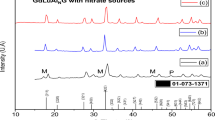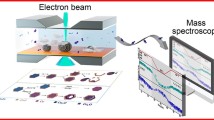Abstract
Catalytic reactions, with iron species as the active phase, require a specific structural organization to achieve good activity and selectivity. Thus, the presence of isolated Fe3+ ions or nanoclusters, the capacity to produce Fe3+/Fe2+ couples, or certain chemisorb reactive molecules are necessary for different reactions. Therefore, if the presence of these structural properties can be demonstrated, it could be inferred that the system could be active in a determined reaction avoiding the screening of catalytic tests. In the present work, using Mössbauer spectroscopy, we have verified that exchanged Fe in hydroxyapatite can produce Fe3+/Fe2+ redox couples which are necessary to achieve good catalytic performances in the NOx, N2O, and NH3 abatement reactions. Besides, this technique allowed us to verify that isolated Fe3+ sites and Fe(III)xOy nanoclusters were able to chemisorb CO molecules. Therefore, it could be thought that Fe/hydroxyapatite system might be active in catalytic reactions in which adsorption and dissociation of CO are necessary.
Graphical Abstract





Similar content being viewed by others
References
Galloni MG, Campisi S, Marchetti SG, Gervasini A (2020) Environmental reactions of air-quality protection on eco-friendly iron-based catalysts. Catalysts 10:1415. https://doi.org/10.3390/catal10121415
Campisi S, Palliggiano S, Gervasini A, Evangelisti C (2019) Finely iron-dispersed particles on β zeolite from solvated iron atoms: promising catalysts for NH3-SCO. J Phys Chem C 123:11723–11733. https://doi.org/10.1021/acs.jpcc.9b01474
Giannakis S (2019) A review of the concepts, recent advances and niche applications of the (photo) Fenton process, beyond water/wastewater treatment: surface functionalization, biomass treatment, combatting cancer and other medical uses. Appl Catal B Environ 248:309–319. https://doi.org/10.1016/j.apcatb.2019.02.025
Pérez De Berti IO, Bengoa JF, Stewart SJ, Cagnoli MV, Pecchi G, Marchetti SG (2016) Effect of activation atmosphere in the Fischer–Tropsch Synthesis using a “quasi-model” catalyst of γ-Fe2O3 nanoparticles supported on SBA-15. J Catal 335:36–46. https://doi.org/10.1016/j.jcat.2015.12.004
Zhang R, Liu N, Lei Z, Chen B (2016) Selective transformation of various nitrogen-containing exhaust gases toward N2 over zeolite catalysts. Chem Rev 116:3658–3721. https://doi.org/10.1021/acs.chemrev.5b00474
Kröcher O, Brandenberger S (2012) Active sites, deactivation and stabilization of Fe-ZSM-5 for the selective catalytic reduction (SCR) of NO with NH3. Chimia 66:687–693. https://doi.org/10.2533/chimia.2012.687
Brandenberger S, Kröcher O, Tissler A, Althoff R (2010) The determination of the activities of different iron species in Fe-ZSM-5 for SCR of NO by NH3. Appl Catal B Environ 95:348–357. https://doi.org/10.1016/j.apcatb.2010.01.013
Long RQ, Yang RT (2002) Selective catalytic oxidation of ammonia to nitrogen over Fe2O3–TiO2 prepared with a sol–gel method. J Catal 207:158–165. https://doi.org/10.1006/jcat.2002.3545
Thomas N, Dionysiou DD, Pillai SC (2021) Heterogeneous Fenton catalysts: a review of recent advances. J Hazard Mater 404:124082. https://doi.org/10.1016/j.jhazmat.2020.124082
Lin SS, Gurol MD (1998) Catalytic decomposition of hydrogen peroxide on iron oxide: kinetics, mechanism, and implications. Environ Sci Technol 32:1417–1423. https://doi.org/10.1021/es970648k
Cano LA, Cagnoli MV, Bengoa JF, Alvarez AM, Marchetti SG (2011) Effect of the activation atmosphere on the activity of Fe catalysts supported on SBA-15 in the Fischer–Tropsch Synthesis. J Catal 278:310–320. https://doi.org/10.1016/j.jcat.2010.12.017
Fihri A, Len C, Varma RS, Solhy A (2017) Hydroxyapatite: a review of syntheses, structure and applications in heterogeneous catalysis. Coord Chem Rev 347:48–76. https://doi.org/10.1016/j.ccr.2017.06.009
Campisi S, Galloni MG, Marchetti SG, Auroux A, Postole G, Gervasini A (2020) Functionalized iron hydroxyapatite as eco-friendly catalyst for NH3-SCR reaction: activity and role of iron speciation on the surface. Chem Cat Chem 12:1676–1690. https://doi.org/10.1002/cctc.201901813
Schiavoni M, Campisi S, Carniti P, Gervasini A, Delplanche T (2018) Focus on the catalytic performances of Cu-functionalized hydroxyapatites in NH3-SCR reaction. Appl Catal A Gen 563:43–53. https://doi.org/10.1016/j.apcata.2018.06.020
Ferri M, Campisi S, Scavini M, Evangelisti C, Carniti P, Gervasini A (2019) In-depth study of the mechanism of heavy metal trapping on the surface of hydroxyapatite. Appl Surf Sci 475:397–409. https://doi.org/10.1016/j.apsusc.2018.12.264
Pérez De Berti I, Bengoa J, Fellenz N, Mercader R, Marchetti S (2015) Mössbauer cell for low-temperature studies of catalysts under reaction conditions. Rev Sci Instrum 86:023903. https://doi.org/10.1063/1.4913382
Lagarec K, Rancourt DG (1998) Recoil-Mössbauer spectral analysis software for windows. University of Ottawa, Ottawa
Blume M, Tjon JA (1968) Mössbauer spectra in a fluctuating environment. Phys Rev 165:446–456. https://doi.org/10.1103/PhysRev.165.456
Khachani M, Kacimi M, Ensuque A, Piquemal J-Y, Connan C, Bozon-Verduraz F, Ziyad M (2010) Iron–calcium–hydroxyapatite catalysts: iron speciation and comparative performances in butan-2-ol conversion and propane oxidative dehydrogenation. Appl Catal A Gen 388:113–123. https://doi.org/10.1016/j.apcata.2010.08.043
Li Y, Nam CT, Ooi CP (2009) J Phys:Conf Ser 187:012024 https://iopscience.iop.org/article/10.1088/1742-6596/187/1/012024
Kramer ER, Morey AM, Staruch M, Suib SL, Jain M, Budnick JI, Wei M (2013) Synthesis and characterization of iron-substituted hydroxyapatite via a simple ion-exchange procedure. J Mater Sci 48:665–673. https://doi.org/10.1007/s10853-012-6779-2
Zecchina A, Geobaldo F, Lamberti C, Bordiga S, Turnes Palomino G, Otero Areán C (1996) Infrared studies of the interaction of carbon monoxide and dinitrogen with ferrisilicate MFI-type zeolites. Catal Lett 42:25–33. https://doi.org/10.1007/BF00814463
Mihaylov M, Ivanova E, Chakarova K, Novachka P, Hadjiivanov K (2011) Reduced iron sites in Fe–BEA and Fe–ZSM-5 zeolites: FTIR study of CO adsorption and 12C16O–13C18O co-adsorption. Appl Catal A Gen 391:3–10. https://doi.org/10.1016/j.apcata.2010.05.014
Ingalls R (1964) Electric-field gradient tensor in ferrous compounds. Phys Rev 133:A787. https://doi.org/10.1103/PhysRev.133.A787
Bancroft GM, Maddock AG, Burns RG (1967) Applications of the Mössbauer effect to silicate mineralogy—I. Iron silicates of known crystal structure. Geochim Cosmochim Acta 31:2219–2246. https://doi.org/10.1016/0016-7037(67)90062-2
Shinno I, Zhe L (1998) Octahedral site Fe (super 2+) quadrupole splitting distributions from the Moessbauer spectra of arrojadite. Am Mineral 83:1316–1322. https://doi.org/10.2138/am-1998-11-1220
Niemantsverdriet J (2007) Spectroscopy in catalysis. An introduction, 3rd edn. Wiley https://www.perlego.com/book/2775810/spectroscopy-in-catalysis-pdf
Wilkinson C, Cheetham AK, Long GJ, Battle PD, Hope DAO (1984) Polarized neutron diffraction and Mossbauer-effect study of the magnetic ordering in Wustite, FeyO. Inorg Chem 23:3136–3141. https://doi.org/10.1021/ic00188a023
Stewart SJ, Cabrera AF, Fellenz NA, Mercader RC, Bengoa JF, Marchetti SG (2016) bi-magnetic iron(iii) oxide nanocrystals embedded in MCM-41 mesoporous silica. J Phys Chem C 120:2993–3000. https://doi.org/10.1021/acs.jpcc.5b10379
Kefirov R, Ivanova E, Hadjiivanov K, Dzwigaj S, Che M (2008) FTIR Characterization of Fe3+ – OH groups in Fe–H–BEA zeolite: interaction with CO and NO. Catal Lett 125:209. https://doi.org/10.1007/s10562-008-9577-3
Wang T, Dorner-Reisel A, Müller E (2004) Thermogravimetric and thermokinetic investigation of the dehydroxylation of a hydroxyapatite powder. J Eur Ceram Soc 24:693–698. https://doi.org/10.1016/S0955-2219(03)00248-6
Hadjiivanov K, Ivanova E, Kefirov R, Janas J, Plesniar A, Dzwigaj S, Che M (2010) Adsorption properties of Fe-containing dealuminated BEA zeolites as revealed by FTIR spectroscopy. Microporous Mesoporous Mater 131:1–12. https://doi.org/10.1016/j.micromeso.2009.11.034
Acknowledgements
The authors acknowledge the financial support of Agencia Nacional de Promoción Científica y Tecnológica FONCyT–ANPCyT (PICT 2017-2808), Consejo Nacional de Investigaciones Científicas y Técnicas (CONICET), and Comisión de Investigaciones Científicas de la Provincia de Buenos Aires (CICPBA) which allowed the development of this work.
Availability of data and material
All data generated or analyzed during this study are included in this published article.
Code availability
Not applicable.
Funding
ANPCyT (PICT 2017-2808).
Author information
Authors and Affiliations
Contributions
These authors contributed equally to work.
Corresponding author
Ethics declarations
Conflict of interest
The authors declare that they have no conflict of interest.
Additional information
Publisher’s note
Springer Nature remains neutral with regard to jurisdictional claims in published maps and institutional affiliations.
Rights and permissions
Springer Nature or its licensor (e.g. a society or other partner) holds exclusive rights to this article under a publishing agreement with the author(s) or other rightsholder(s); author self-archiving of the accepted manuscript version of this article is solely governed by the terms of such publishing agreement and applicable law.
About this article
Cite this article
Bengoa, J., Campisi, S., Gervasini, A. et al. Mössbauer spectroscopy as a tool to predict the catalytic activity of the Fe3+ sites in an exchanged Fe/hydroxyapatite system. J Nanopart Res 25, 100 (2023). https://doi.org/10.1007/s11051-023-05747-w
Received:
Accepted:
Published:
DOI: https://doi.org/10.1007/s11051-023-05747-w




